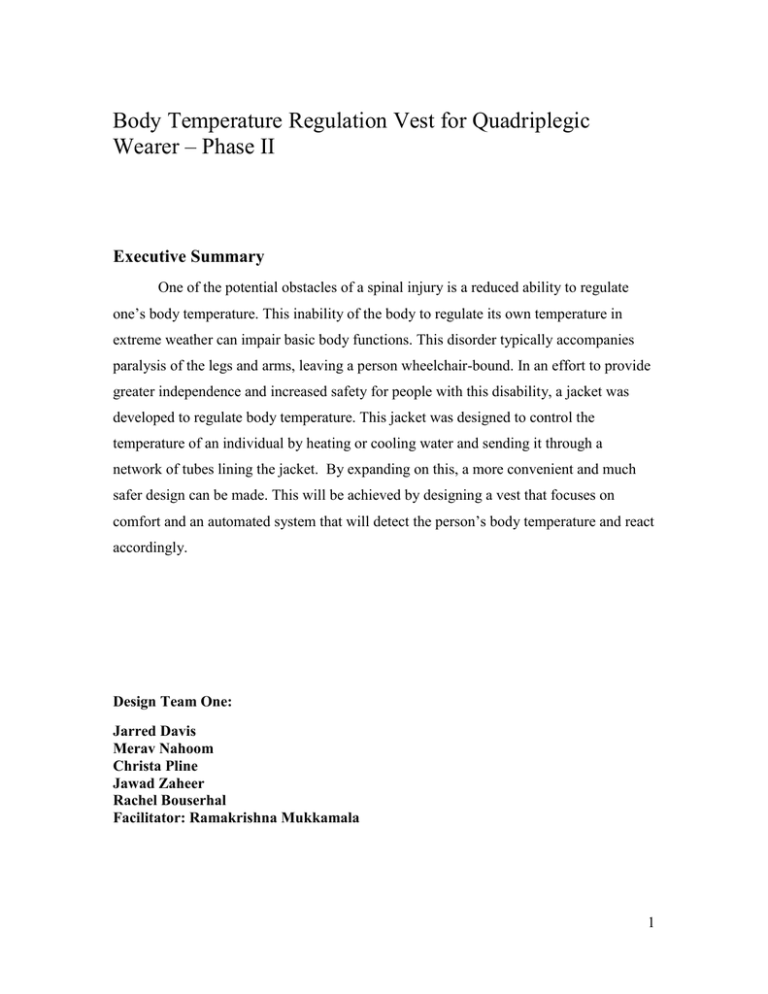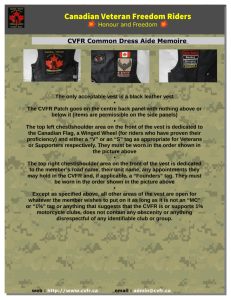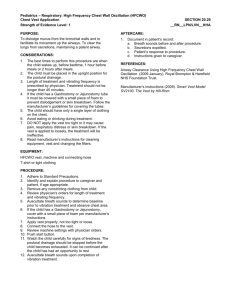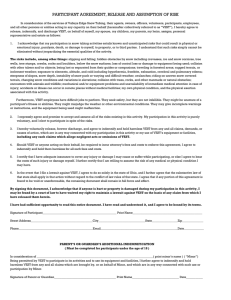Team Proposal
advertisement

Body Temperature Regulation Vest for Quadriplegic Wearer – Phase II Executive Summary One of the potential obstacles of a spinal injury is a reduced ability to regulate one’s body temperature. This inability of the body to regulate its own temperature in extreme weather can impair basic body functions. This disorder typically accompanies paralysis of the legs and arms, leaving a person wheelchair-bound. In an effort to provide greater independence and increased safety for people with this disability, a jacket was developed to regulate body temperature. This jacket was designed to control the temperature of an individual by heating or cooling water and sending it through a network of tubes lining the jacket. By expanding on this, a more convenient and much safer design can be made. This will be achieved by designing a vest that focuses on comfort and an automated system that will detect the person’s body temperature and react accordingly. Design Team One: Jarred Davis Merav Nahoom Christa Pline Jawad Zaheer Rachel Bouserhal Facilitator: Ramakrishna Mukkamala 1 Contents Introduction ....................................................................................................................... 3 Background ....................................................................................................................... 4 Proposed Solution ............................................................................................................. 5 Design Specifications ........................................................................................................ 5 Safety .............................................................................................................................. 6 Power Consumption ........................................................................................................ 6 Automatic Control .......................................................................................................... 6 Accessibility.................................................................................................................... 7 Comfort ........................................................................................................................... 6 Cost ................................................................................................................................. 7 Robustness ...................................................................................................................... 7 Portability........................................................................................................................ 7 Hardware Requirements .................................................................................................. 9 Temperature Sensor ....................................................................................................... 10 Microcontroller .............................................................................................................. 10 Thermoelectric Device with Pump ................................................................................ 10 User Interface and Casing .............................................................................................. 11 DC/DC Converter .......................................................................................................... 11 Heat Sink ........................................................................................................................ 11 Tubing and Interconnects ............................................................................................... 12 Garments ........................................................................................................................ 12 Software ........................................................................................................................... 12 Risk Analysis ................................................................................................................... 13 Project Management ....................................................................................................... 13 Non-technical Roles ...................................................................................................... 13 Technical Roles ............................................................................................................. 14 Cost and Budget ............................................................................................................ 14 Project Timeline ............................................................................................................ 15 References ........................................................................................................................ 15 2 Introduction A healthy human is able to maintain a constant body temperature of 98.6°F (37°C) despite the temperature of the environment. In a hot environment, the body sends a signal to the brain via the spinal cord to say the body is overheating; the brain then sends a signal back down the spinal cord and tells the body to cool itself by perspiration. Many people with spinal cord injuries, however, are unable to complete this operation. With the loss of the ability to sweat, a person needs a careful control of his or her environmental conditions or their body temperature will begin to rise excessively. Likewise in a cold environment, the body may not be able to get the messages through to the brain that the body is cooling down, and if left untreated, the person will soon become hypothermic. There are a variety of clothing products designed to heat or cool individuals in order to regulate body temperature. Some heating garments use a heat source connected to stationary equipment, with a heating system attached to the clothing. Due to the high power requirements, the battery power needed for this type of system is either very bulky (lead acid) or prohibitively expensive (lithium-ion), resulting in very limited mobility because of the electrical connections. Cooling vests use ice water that is pumped from a reservoir and gets circulated throughout the vest. These designs, aimed at those working or living in harsh environments, often are not intended for those with medical conditions, such as quadriplegia. Those that are available have downfalls including limited mobility and safety issues. A project was started last semester to rectify this. 3 Background The goal of this project is to modify a heating/cooling system for the use of quadriplegic wearers. Last semester, in combined effort with the MSU Center for Persons with Disabilities, a jacket was designed to control the temperature of an individual by heating or cooling water and sending it through a network of tubes lining the jacket. The system attaches directly to, and is powered by, the users’ wheelchair. When activated, it pumps heated (or cooled) water though medical grade tubing in the jacket, this in turn influences the temperature of the wearer. There are limitations in the design that must be addressed to complete this project. Safety is the most important factor to consider when designing this vest. In the current design the system used water that is pumped though a hose system. A temperature regulator was not implemented, which could cause serious injury if the water surpasses a safe temperature. Therefore, the water temperature must be monitored by the system to ensure that the vest does not get too hot. If the controller reads a temperature that is potentially dangerous a signal will be sent to shut the entire system off. Power conservation is another issue from the original design. The system could not hold an automated setting because of the extensive power that was drawn from the wheelchair’s battery. Since the system is drawing power from the battery of the wheelchair, as much energy should be utilized as possible to prevent too much power loss to the chair. A voltage divider will be used to provide an appropriate voltage level to all the major components of the system including the microcontroller. In order for this design to be truly effective it must be easy for the customer to use. In phase I of the project there was a limited user control. The only settings were off, 4 heating and cooling. The switches for these settings were not accessible and were limited in range of operation. Our task is to develop an automated system that will detect the user’s body temperature and adjust the temperature of the jacket according to his needs. In addition to that, the control of this system will be within reach of the user. Manual, automatic, and off will be the type of options available. While operating in the manual condition, the user will be able to select from a range of temperatures that will allow for maximum comfort. Proposed Solution In addition to the limitation addressed in the old design a number of new features will be added. A comfortable, sturdy vest will be attached to the temperature regulation system. The system will have manual and automatic capabilities which can be controlled by adding a microcontroller. This automatic setting will require a number of temperature sensors to be added to the system. These added features will not, however, add to the size of the device; it will still be transportable on the back of a wheelchair. Design Specifications When designing a body temperature regulation vest, there are important parameters to be met: Safety, Power consumption, Automatic control, Accessibility, Comfort, Cost, Robustness, and Portability. 5 Safety Safety is the most critical aspect in this design. Sufficient measures need to taken to account for the high voltage power supply. The actual control of the heating and cooling system will be implemented via relays switched by the microcontroller. These relays offer protection to the interface by isolating them from the higher voltages. Secondly, we need to take sufficient readings of the liquid temperature so that it cannot cause burns to the body since the vest will be worn very close to the skin. The temperature of the water running through the tubes has to be maintained within a safe range. If the system reaches a temperature outside of the safety range, it will be detected by the microcontroller and automatically shut off. Power consumption This design requires power that is supplied by the user’s wheelchair. Power to the wheelchair is primary; therefore, the power consumption of our design will be regulated for minimum power usage. Automatic control Body, ambient, and water temperature will be measured using thermistors. The fluctuation in resistance will be monitored and recorded. It will then be matched to the appropriate temperature. Once the specified temperatures are received the system will turn on or off automatically. Accessibility Since this project is targeted towards people with reduced mobility, accessibility needs to be easy and comfortable for the user. Currently, the main control interface is 6 located in a place that is difficult to access, so a secondary control interface will be extended to the user for convenience. Comfort Considering again the reduced mobility of the user, the design of the vest needs to be simple and convenient. A zip up vest would be much easier to wear than a pull over shirt. Comfort in wearing this while sitting in a wheel chair is important. The vest will be thin and easily adjustable. Cost Low cost is important to be able to make this available for as many users as possible. However, other design parameters, such as safety issues, are more important and will be considered as a priority in cost decisions. Robustness This design will be used in a variety of temperatures. The robustness of this design in extremely high and low temperatures is very necessary. All parts used will have to sustain desired functionality in these extreme temperatures. Portability The system needs to be of a suitable size as it is to be attached to, and transported with, a wheelchair. Using power from the wheelchair itself helps in this area by avoiding unnecessary cords and chargers. 7 In Table 1 the design specifications for this project are ranked in order of significance with a relative weight specified. These weights will be used in Table 2 to help decide which components are most appropriate for this project. Factor Relative Order of Significance 1 Relative Weight Power Consumption 2 9 Automatic Control 3 9 Accessibility 4 8 Comfort 5 8 Cost 6 6 Robustness 7 5 Portability 9 4 Safety 10 Table 1 Design Factor Matrix Design Microcontroller PIC Factor Safety Power Consumption Automatic Control Accessibility Comfort Cost Robustness Portability Total PSoC Thermoelectric Device Peltier Heater Garment Style Jacket Vest Material PolyMesh Nylon Thermometer Location Arm Pit Ear Weight 10 5 5 9 6 5 5 5 5 6 5 9 5 5 7 6 5 5 5 5 5 5 9 8 8 6 5 4 6 5 5 7 5 5 8 5 5 6 5 5 8 5 5 8 5 9 6 5 4 4 5 3 5 4 4 5 6 5 5 7 7 5 5 5 5 5 9 7 9 5 5 5 5 5 5 5 5 7 8 7 5 5 5 5 2 5 5 5 351 363 463 336 312 383 394 330 413 292 Table 2 Component Based Design Matrix 8 Hardware Requirements This design project is based on the design that was built last semester; thus, the basic hardware has already been setup. Our task is to build on the top of the current system and add additional features to the design. Figure 1 shows a diagram of the functionality of the new system design. Figure 1: FAST Diagram There are a number of components that will be used to implement this design. They include temperature sensors, a microcontroller, a thermoelectric device, a pump, user interface, DC/DC converters, a heat sink, tubing, interconnects and the vest itself. 9 Temperature Sensor One of the key components for the project is the temperature sensors. Three thermistors are needed to measure different temperatures at different positions. First, there needs to be a sensor to measure the body temperature under the armpits. This sensor requires a great deal of accuracy and comfort. The second sensor will measure the temperature of the liquid flowing through the tubes; for this we will be using a submersible stainless steel thermistor. The final sensor will be a digital temperature sensor used to measure the ambient temperature. Microcontroller The choice of microcontroller is important as it will be in charge of the system functionality. Due to the simplicity of the control system, and in the interest of reducing cost, a basic controller will be used. Because of its convenience and extended peripherals, a PSoC (Programmable System-on-Chip) was chosen. Thermoelectric Device with Pump A Peltier junction transfers heat/cool from one side of the device to the other. The direction of heat transfer is controlled by the polarity of the current. When the polarity is reversed, it changes the direction of transfer and thus the sign of the heat absorbed/dispersed. A small pump is attached to provide adequate flow rate for the liquid in the tubes. A new, less power consuming Peltier Junction will be added, but the pump will be carried forward from the current design. 10 User Interface and Casing The user interface will be through an LCD screen and a basic keypad. The LCD display will show the current temperatures and the settings will be changed using the keypad. The same original casing will be utilized with some modifications to attach the new components. DC/DC Convertor A 24V lead-acid battery, which is a standard for electric wheelchairs, will power the design project. The current design already has a DC/DC convertor that converts 24V to about 13V, which is the required voltage for the Peltier Junction to function properly. Additional circuitry to convert 13V to 5V is needed as all the microprocessors and the digital sensors operate in the range of 3.3 V to 5.5V Heat Sink The current design of the heat sink is sufficient for the project and does not need further improvement at this stage. The thermoelectric (TE) module provides maximum cooling performance, while the heat sink dissipates the maximum amount of heat this module can generate. The heat exchanger was chosen for its large copper surface, along with a flow rate that is compatible with our pump. Tubing and Interconnects 2mm Tygon tubing will be used for the liquid to flow as used in the current design due to its low price, high heat tolerance and flexibility. Water will continue to be used as 11 the liquid in the tubes. Tubes will be connected with Quick-Connect interconnects as in the current design for drip-free operation. Garments The design is based on a body temperature regulation vest, which is fitted to the body. The durability of the garment is important as it contains the whole system of tubing. All the heating/cooling is done through these tubes in the vest. The material will allow for the temperature sensor to easily sit under the armpit. Software The microcontroller will control the automatic setting of this system. The PSoC comes with a free downloadable program PSoC Designer which will be utilized to program the system. The programming language that will be used is C. Risk Analysis The main risk in this project is the water temperature in the tubes. If it gets outside of the specified range it could be potentially damaging to the skin. This will be accounted for by making the correct precautionary steps of measuring the water temperature and informing the system how to react. Another risk is the power consumption of the system. All of the components could be damaged by the twenty four volt power source. The DC/DC converters will step 12 down the voltage to these components. By reducing the power drawn by these components we reduce the chance of overheating the system. Project Management The following members will be part of the team to design a Body Temperature Regulation Vest for Quadriplegic Wearer - Phase II: Jarred Davis, Christa Pline, Rachelle Bouserhal, Jawad Zaheer and Merav Nahoom. The non-technical and technical roles are shown in Table 1 and Table 2. The team has sufficient labor resources for completing the project on schedule and under budget. Non-technical Roles The non-technical roles are assigned according to the initial project assignments, and are shown in Table 3. Name Non-Technical Roles Jarred Davis Manager Christa Pline Document Prep Rachelle Bouserhal Lab Coordinator Jawad Zaheer Presentation Prep Merav Nahoom Web Coordinator Table 3 - Non-technical Roles 13 Technical Roles The technical roles are assigned according to each person’s interest and knowledge, and are shown in Table 4. Name Technical Roles Jarred Davis Power Christa Pline Circuit Assembly Rachelle Bouserhal User Interface Jawad Zaheer Temperature Sensors Merav Nahoom Software/Programming Table 4 - Technical Roles Cost and Budget Many components are already included in the current design. Several will be used in the new design including the heatsink, fans, water pump, tubing, and connectors. This will help in keeping the cost within the budget. Table 5 shows a breakdown of the cost estimate for the remaining components. 14 Total Budget: $500 Parts Cost Range Vest $100 - $120 Temperature Sensors $20-50 Circuit Components $10 -$20 LCD Display $10-$30 Relays $10-$20 Microcontrollers $10 - $20 Thermoelectric Device $20-$30 Total $180 - $290 Table 5 outlines the project budget estimate. Project Timeline Gantt Chart is attached. References High-Performance Modules. Web. <http://www.tetech.com/Peltier-Thermoelectric-CoolerModules/High-Performance.html>. Poly-Mesh Breathable Bonding, Spun Bonded Fabric. Web. <http://www.made-inchina.com/trade-offers/offerviewGbSJEKvMOnkm/Sell-Poly-Mesh-Breathable-Bonding-SpunBonded-Fabric.html>. Temperature Regulation. Web. <http://www.apparelyzed.com/temperature.html>. 15






